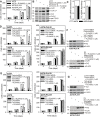Inhibition of YAP function overcomes BRAF inhibitor resistance in melanoma cancer stem cells
- PMID: 29299145
- PMCID: PMC5746380
- DOI: 10.18632/oncotarget.22628
Inhibition of YAP function overcomes BRAF inhibitor resistance in melanoma cancer stem cells
Abstract
Treating BRAF inhibitor-resistant melanoma is an important therapeutic goal. Thus, it is important to identify and target mechanisms of resistance to improve therapy. The YAP1 and TAZ proteins of the Hippo signaling pathway are important drivers of cancer cell survival, and are BRAF inhibitor resistant factors in melanoma. We examine the role of YAP1/TAZ in melanoma cancer stem cells (MCS cells). We demonstrate that YAP1, TAZ and TEAD (TEA domain transcription factor) levels are elevated in BRAF inhibitor resistant MCS cells and enhance cell survival, spheroid formation, matrigel invasion and tumor formation. Moreover, increased YAP1, TAZ and TEAD are associated with sustained ERK1/2 activity that is not suppressed by BRAF inhibitor. Xenograft studies show that treating BRAF inhibitor-resistant tumors with verteporfin, an agent that interferes with YAP1 function, reduces YAP1/TAZ level, restores BRAF inhibitor suppression of ERK1/2 signaling and reduces tumor growth. Verteporfin is highly effective as concentrations of verteporfin that do not impact tumor formation restore BRAF inhibitor suppression of tumor formation, suggesting that co-treatment with agents that inhibit YAP1 and BRAF(V600E) may be a viable therapy for cancer stem cell-derived BRAF inhibitor-resistant melanoma.
Keywords: BRAF inhibitor; YAP and TAZ; cancer stem cell; drug resistance; melanoma.
Conflict of interest statement
CONFLICTS OF INTEREST The authors declare no conflicts of interest.
Figures







Comment in
-
Findings of Research Misconduct.Fed Regist. 2024 Aug 15;89(158):66420-66422. Fed Regist. 2024. PMID: 39161428 Free PMC article. No abstract available.
References
-
- Davies H, Bignell GR, Cox C, Stephens P, Edkins S, Clegg S, Teague J, Woffendin H, Garnett MJ, Bottomley W, Davis N, Dicks E, Ewing R, et al. Mutations of the BRAF gene in human cancer. Nature. 2002;417:949–54. https://doi.org/10.1038/nature00766 - DOI - PubMed
-
- Lito P, Pratilas CA, Joseph EW, Tadi M, Halilovic E, Zubrowski M, Huang A, Wong WL, Callahan MK, Merghoub T, Wolchok JD, de Stanchina E, Chandarlapaty S, et al. Relief of profound feedback inhibition of mitogenic signaling by RAF inhibitors attenuates their activity in BRAFV600E melanomas. Cancer Cell. 2012;22:668–82. https://doi.org/10.1016/j.ccr.2012.10.009 - DOI - PMC - PubMed
-
- Spagnolo F, Ghiorzo P, Queirolo P. Overcoming resistance to BRAF inhibition in BRAF-mutated metastatic melanoma. Oncotarget. 2014;5:10206–21. https://doi.org/10.18632/oncotarget.2602 - DOI - PMC - PubMed
-
- Hauschild A, Grob JJ, Demidov LV, Jouary T, Gutzmer R, Millward M, Rutkowski P, Blank CU, Miller WH, Jr, Kaempgen E, Martín-Algarra S, Karaszewska B, Mauch C, et al. Dabrafenib in BRAF-mutated metastatic melanoma: a multicentre, open-label, phase 3 randomised controlled trial. Lancet. 2012;380:358–65. https://doi.org/10.1016/S0140-6736(12)60868-X - DOI - PubMed
-
- McArthur GA, Chapman PB, Robert C, Larkin J, Haanen JB, Dummer R, Ribas A, Hogg D, Hamid O, Ascierto PA, Garbe C, Testori A, Maio M, et al. Safety and efficacy of vemurafenib in BRAF(V600E) and BRAF(V600K) mutation-positive melanoma (BRIM-3): extended follow-up of a phase 3, randomised, open-label study. Lancet Oncol. 2014;15:323–32. https://doi.org/10.1016/S1470-2045(14)70012-9 - DOI - PMC - PubMed
Grants and funding
LinkOut - more resources
Full Text Sources
Other Literature Sources
Molecular Biology Databases
Research Materials
Miscellaneous

